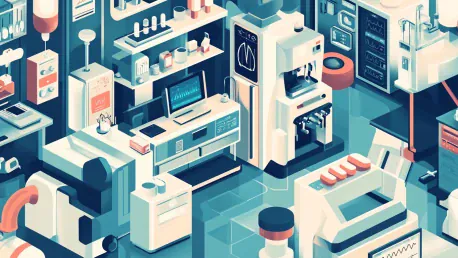The Internet of Medical Things (IoMT) is transforming the healthcare industry by integrating advanced technology into medical devices and systems. This revolution is enhancing patient care, improving diagnostics, and enabling more efficient healthcare delivery through the seamless connectivity of medical devices. The IoMT is ushering in a new era of healthcare that leverages real-time data, advanced analytics, and patient-centered innovations.
The Rise of Real-Time Monitoring
IoMT devices are now capable of continuously collecting and transmitting health data in real-time. This allows healthcare providers to remotely monitor patient health and make timely medical interventions. For patients with chronic diseases, real-time monitoring is crucial as it ensures that any changes in their condition are detected early, leading to better management and outcomes. By providing continuous insights into a patient’s health, IoMT devices help in reducing hospital readmissions and emergency visits, while also supporting better management of lifestyle changes essential for maintaining health.
Real-time monitoring has significant implications for post-operative care as well. Patients recovering from surgery can be monitored remotely, allowing healthcare professionals to detect potential complications early and intervene promptly. This approach not only enhances patient safety but also reduces the burden on healthcare facilities by minimizing the need for extended hospital stays. The ability to monitor patients in their homes contributes to a more comfortable and less stressful recovery process, further improving patient satisfaction and outcomes.
Data-Driven Healthcare
The vast amounts of data generated by IoMT devices are being used to gain valuable insights. Advanced analytics and predictive algorithms are enabling early diagnosis and personalized treatment plans. This data-driven approach is not only improving the accuracy of medical diagnoses but also enhancing the effectiveness of treatments, leading to better patient outcomes. By harnessing this data, healthcare providers can identify patterns and trends that might not be evident through traditional methods, allowing for a more proactive and anticipatory approach to patient care.
Additionally, data-driven healthcare supports population health management by identifying at-risk groups and facilitating targeted interventions. Public health officials can leverage IoMT data to monitor trends, track the spread of diseases, and allocate resources more effectively. Personalized treatment plans based on predictive analytics ensure that each patient receives care tailored to their specific needs, improving overall health outcomes and reducing the incidence of adverse events.
Empowering Patients with Wearable Devices
Wearable devices and health apps are empowering patients to take control of their health. These tools enable individuals to monitor their vital signs, manage chronic conditions, and stay engaged with their treatment plans. As a result, patients are becoming more proactive about their health, leading to increased compliance with medical advice and improved overall well-being. Wearable devices provide real-time feedback, enabling users to make informed decisions about their health and lifestyle choices, thus promoting a more active and preventive approach to healthcare.
Furthermore, wearable devices enhance the physician-patient relationship by facilitating better communication and data sharing. Patients can share their health data with their healthcare providers, enabling more informed consultations and personalized care recommendations. This continuous flow of information ensures that healthcare providers have a comprehensive understanding of their patients’ health status, leading to more effective and timely interventions. By empowering patients with the tools to manage their own health, wearable devices contribute to a more patient-centered healthcare system that emphasizes engagement and self-management.
The Impact of Remote Accessibility
IoMT is making healthcare more accessible by enabling remote consultations and telemedicine services. Healthcare providers can access critical patient data from anywhere, reducing the need for in-person visits. This remote accessibility is particularly beneficial for patients in rural or underserved areas, where access to healthcare facilities may be limited. Telemedicine services, supported by IoMT devices, allow patients to receive medical advice, diagnoses, and treatments without the need to travel long distances, thereby improving access to care and reducing healthcare disparities.
In addition to improving access, remote monitoring and telemedicine also enhance the efficiency of healthcare delivery. Healthcare providers can manage more patients simultaneously, streamline their workflows, and allocate resources more effectively. This increased efficiency translates into shorter wait times for patients, more timely interventions, and overall improvements in the quality of care. By integrating remote access capabilities, IoMT is transforming healthcare delivery into a more flexible and patient-centric model, ultimately improving health outcomes and patient satisfaction.
Technological Innovations Driving IoMT
Technological advancements such as Artificial Intelligence (AI) and Machine Learning (ML) are playing a pivotal role in the evolution of IoMT. These technologies are enhancing the capabilities of medical devices and improving the accuracy of data analysis. The deployment of 5G networks is also revolutionizing IoMT by enabling faster and more reliable data transmission, which is essential for real-time monitoring and telemedicine. AI and ML algorithms can analyze vast amounts of complex medical data quickly and accurately, providing insights that support early detection of diseases, personalized treatment plans, and predictive analytics for preventive care.
Moreover, the integration of AI and ML in IoMT devices is transforming diagnostic processes, making them more precise and less invasive. For instance, AI-powered imaging tools can detect abnormalities in medical images with high accuracy, reducing the need for invasive procedures and enabling early intervention. The combination of AI, ML, and 5G connectivity is also paving the way for advanced telemedicine applications, such as remote surgeries and virtual reality-based rehabilitation programs, further expanding the possibilities of IoMT-enabled healthcare.
The Growing Market for Wearable Devices
The market for wearable health devices is expanding rapidly. Innovations in wearable technology, such as non-invasive blood glucose monitoring and comprehensive vital sign measurement, are driving this growth. These advancements are making wearable devices more accurate and multifunctional, increasing their adoption for continuous health tracking. Wearable devices are evolving beyond simple fitness trackers to sophisticated health monitoring tools that can detect and alert users to potential health issues in real-time, providing valuable insights that support proactive health management.
In addition to their healthcare applications, wearable devices are becoming increasingly popular in the consumer market. Many individuals are adopting wearables for fitness tracking, sleep monitoring, and overall wellness management. This growing consumer interest is driving further innovation and competition in the market, resulting in more advanced, affordable, and user-friendly devices. As wearable technology continues to evolve, it is expected to play an even more significant role in preventive healthcare, early diagnosis, and chronic disease management, ultimately contributing to better health outcomes and quality of life.
Sustainability in IoMT
As the healthcare industry becomes more environmentally conscious, there is a growing focus on sustainability in IoMT. This includes the use of eco-friendly materials, energy-efficient device designs, and practices that promote recycling and reuse. Sustainability efforts are addressing the environmental impact of healthcare operations, ensuring that the benefits of IoMT extend beyond patient care. By adopting sustainable practices, IoMT companies are not only contributing to environmental conservation but also improving the long-term viability and resilience of healthcare systems.
Furthermore, sustainability in IoMT can lead to cost savings and operational efficiencies for healthcare providers. For instance, energy-efficient devices reduce power consumption, lowering utility costs and minimizing the carbon footprint of healthcare facilities. Similarly, the use of recyclable materials and modular device designs can reduce waste and facilitate easier maintenance and upgrades. By prioritizing sustainability, the IoMT industry is demonstrating its commitment to responsible innovation and sustainable healthcare practices that benefit both patients and the planet.
Shifting Consumer Behavior
Consumer demand for personalized healthcare and remote care solutions is on the rise. Patients prefer devices that allow them to monitor their health autonomously and expect robust data privacy measures. IoMT companies are responding to these demands by developing innovative solutions that prioritize user experience and data security. As patients become more tech-savvy and health-conscious, the need for user-friendly, secure, and reliable IoMT devices is increasing, driving further innovation and competition in the market.
Additionally, the COVID-19 pandemic has accelerated the adoption of remote healthcare solutions and heightened awareness of the importance of health monitoring. Consumers are now more willing to embrace digital health technologies and are more proactive about managing their health. This shift in consumer behavior is pushing IoMT companies to continuously innovate and improve their products, ensuring they meet the evolving needs and expectations of patients. By focusing on personalization and data security, IoMT companies can build trust with consumers and foster greater adoption of their products and services.
Key Players and Market Dynamics
Leading companies such as GE Healthcare, Boston Scientific Corporation, and Apple Inc. are at the forefront of the IoMT revolution. These key players are driving innovation and shaping the competitive landscape of the market. The IoMT market is projected to grow significantly, driven by technological advancements and the increasing adoption of digital health solutions. This growth presents substantial opportunities for both established companies and new entrants. By investing in research and development, forming strategic partnerships, and expanding their product portfolios, these companies are positioning themselves to capitalize on the growing demand for IoMT solutions.
In addition to technological innovation, market dynamics are influenced by regulatory developments and industry standards. Governments and regulatory bodies are increasingly recognizing the potential of IoMT and are working to establish guidelines that ensure the safety, efficacy, and interoperability of IoMT devices. These regulatory frameworks are essential for fostering innovation while protecting patient safety and data privacy. As the market continues to evolve, companies that can navigate these regulatory challenges and adapt to changing industry standards will be well-positioned for success in the competitive IoMT landscape.
Recent Developments and Future Prospects
The Internet of Medical Things (IoMT) is revolutionizing the healthcare industry by incorporating advanced technology into medical devices and systems. This groundbreaking integration is significantly enhancing patient care by providing more accurate diagnostics and enabling more efficient healthcare delivery.
By connecting medical devices seamlessly, the IoMT harnesses real-time data and advanced analytics to bring about a new era in healthcare. This technological advancement allows for continuous monitoring, which greatly improves patient outcomes. The data collected from these devices can help healthcare providers to make better-informed decisions, ultimately leading to personalized and more effective treatments.
Moreover, the IoMT is fostering innovations focused on patient-centered care. These innovations not only improve the quality of healthcare services but also reduce the strain on healthcare providers. Remote monitoring, for instance, allows patients to receive care from the comfort of their homes, which is particularly beneficial for those with chronic conditions or those requiring long-term care.
Overall, the IoMT is transforming the healthcare landscape by making it more connected and efficient, ensuring that patients receive the best possible care tailored to their specific needs. This evolution in healthcare technology stands to benefit not just patients, but the entire healthcare system, by making it more responsive, data-driven, and patient-focused.









